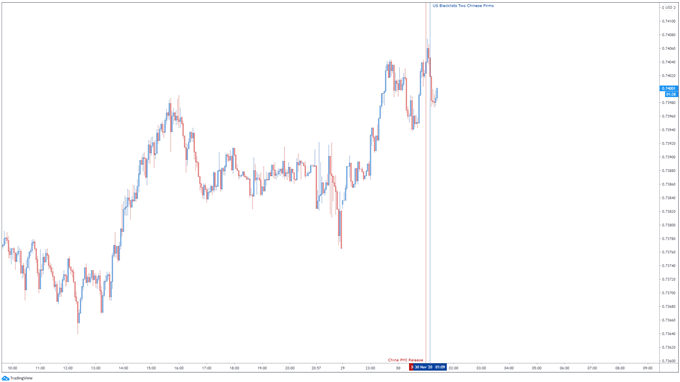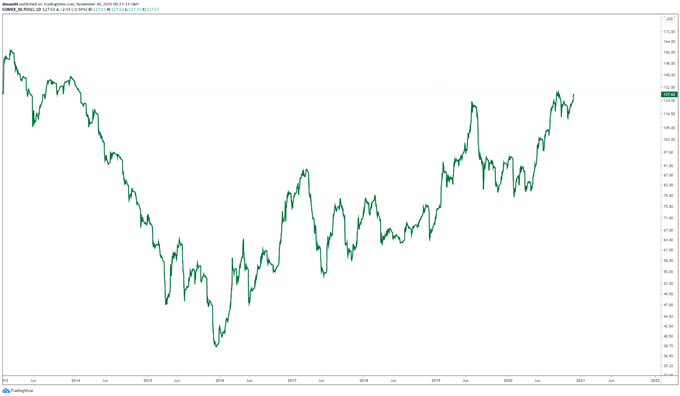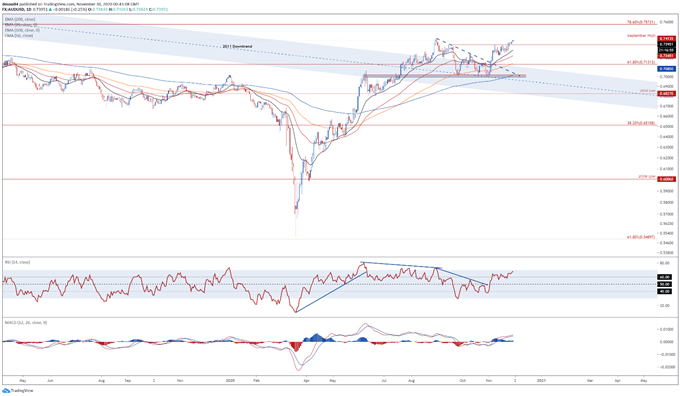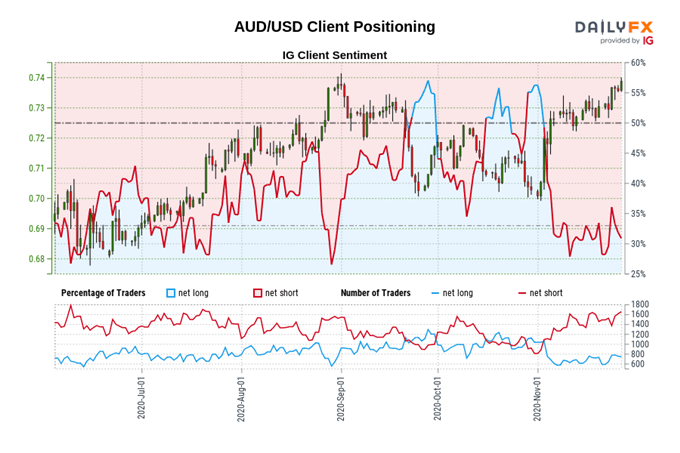Australian Dollar, Chinese PMI, SMIC, CNOOC, Australia-China Trade War – Talking Points:
- The Australia Dollar initially pushed higher on robust Chinese economic data.
- However, the Trump administration’s move to blacklist SMIC and CNOOC propelled the trade-sensitive currency lower.
- Deteriorating Australia-China relations threatens to undermine the nation’s economic recovery.
- AUD/USD rates eyeing yearly high after breaching key resistance.
The Australian Dollar clambered back above the psychologically imposing 0.7400 mark on the back of robust economic data out of China, before retreating lower after the Trump administration added two Chinese firms – Semiconductor Manufacturing International Corporation (SMIC) and China National Offshore Oil Corporation (CNOOC) – to its defense blacklist.
Manufacturing PMI rose to 52.1 in November, surpassing consensus estimates of a 51.5 print, while non-manufacturing PMI also exceeded expectations, rising to 56.4.
This release indicates that the Chinese economy is continuing to recover strongly from the February nadir and with a substantial fiscal safety net yet to be deployed, this significant rebound in economic activity looks set to prolong.
Beijing ordered regional governments to sell 3.75 trillion yuan of bonds by the end of October, building on the 2.27 trillion already issued by the end of July and surpassing the total amount of debt issued in 2019.
This bodes well for the trade-sensitive AUD in the near term and could propel the currency to fresh yearly highs in the coming days.
However, deteriorating Australia-China relations may take some of the wind out of the currency’s sails.

AUD/USD 3-minute chart created using Tradingview
Australia-China Trade War Heating Up
The marked escalation in tensions between Australia and China may weigh on the trade-sensitive currency in the near term, after Beijing announced new tariffs of up to 200% on Australian wine exports.
This move builds on a series of targeted measures enforced by Chinese authorities in the last year, with over $20 billion worth of exports falling into the cross hairs. Trade barriers have also been imposed on coal, timber, seafood and barley exports in recent months.
However, Australia’s most valuable export has been left untouched by Beijing, with delivery of iron ore to the world’s second largest economy continuing at a healthy rate.
Of course, iron ore could prove to be a future target given recent comments from a Chinese government official in Canberra, warning that “China is angry. If you make China the enemy, China will be the enemy”.

Data source – Bloomberg
The comments coming shortly after the Chinese embassy released a dossier of 14 grievances to local news outlets, in what seems to be a political play to pressure the Federal government into reversing its position on several key issues.
The disputes ranging from Prime Minister Scott Morrison’s calls for an independent investigation into the origins of Covid-19 to Australia’s condemnation of Beijing’s actions in Hong Kong and Xinjiang.
Clearly, this volatile situation could threaten to upend Australia’s nascent economic recovery and has seen Treasurer Josh Frydenberg call for a return to “respectful and beneficial” dialogue between the two nations.
Nevertheless, with iron ore seemingly safe for the time-being, AUD may continue to benefit from the historic surge in the price of the metallic rock and consistent Chinese demand.

Iron ore futures daily chart created using Tradingview
Wait-and-See RBA to Underpin AUD
As mentioned in previous reports, the Reserve Bank of Australia delivered what appears to be its last interest rate cut – for the foreseeable future at least – in November.
Policymakers stated that “the Board is not contemplating a further reduction in interest rates [and] continues to view a negative policy rate as extraordinarily unlikely”.
The central bank also noted that “recent economic data have been a bit better than expected and the near-term outlook is better than it was three months ago”.
With that in mind, it seems relatively unlikely that the RBA will adjust its monetary policy settings further at its upcoming meeting on December 1.
Therefore, the local currency looks set to continue pushing higher as investors discount further easing from the RBA.
AUD/USD Daily Chart – Yearly High Within Touching Distance

AUD/USD daily chart created using Tradingview
From a technical perspective, AUD/USD rates look poised to climb to fresh yearly highs, after clearing resistance at the November 9 high (0.7340).
With the RSI eyeing a push into overbought territory and the MACD indicator climbing to its highest levels since late September, the path of least resistance seems to favour the upside.
Breaching the September high (0.7413) is required to neutralize near-term selling pressure and bring the 78.6% Fibonacci (0.7573) into play.
Conversely, failure to gain a firm foothold above the 0.7400 mark could ignite a pullback towards the September 16 high (0.7345).

IG Client Sentiment data shows 26.70% of traders are net-long with the ratio of traders short to long at 2.74 to 1.The number of traders net-long is 20.11% lower than yesterday and 0.17% higher from last week, while the number of traders net-short is 4.18% lower than yesterday and 7.87% higher from last week.
We typically take a contrarian view to crowd sentiment, and the fact traders are net-short suggests AUD/USD prices may continue to rise.
Traders are further net-short than yesterday and last week, and the combination of current sentiment and recent changes gives us a stronger AUD/USD-bullish contrarian trading bias
-- Written by Daniel Moss, Analyst for DailyFX
Follow me on Twitter @DanielGMoss









